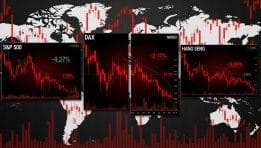Founded in 2012 in San Francisco, Figma is a collaborative cloud-based design platform that revolutionized the way teams create and iterate on user interfaces. Unlike traditional design tools like Adobe XD or Sketch, Figma enables real-time co-design, allowing multiple team members—designers, developers, and product managers—to work simultaneously on the same project.
Its core business model is based on SaaS subscriptions, offered on a freemium-to-enterprise scale. The company’s key products include its flagship design editor, FigJam (for whiteboarding and collaboration), and recently introduced AI tools that accelerate design workflows. Today, over 13 million people use Figma monthly, with approximately two-thirds being non-professional designers—a clear sign that Figma has penetrated deeply into adjacent sectors like development, marketing, and education.
A $68 Billion Debut: The Numbers Behind the IPO
On Thursday, July 31, 2025, Figma made its public debut on the New York Stock Exchange (Ticker: F) in what became one of the most talked-about IPOs in recent tech history. The company priced its shares at $33, raising $1.2 billion, mostly from the sale of existing shareholder equity. The stock opened at $85, briefly surged past $112, and eventually closed at $115.50—representing a +250% gain from its IPO price and giving Figma a market capitalization of approximately $68 billion.
The overwhelming investor demand sent a clear signal: the market may be ready to embrace high-growth tech IPOs once again. NYSE President Lynn Martin commented that Figma’s success might “open the floodgates” for more tech firms to test the waters of public markets in the coming months.
Financials: Rapid Growth, Positive Margin, and Caution Flags
For the second quarter of 2025, Figma reported revenue of $247 million to $250 million, marking year-over-year growth of roughly 40%. More notably, the company posted operating income between $9 million and $12 million, reflecting its first sustained period of operational profitability—a rare achievement among fast-scaling SaaS companies.
However, not all signs are green. According to GuruFocus, Figma currently exhibits six financial warning signs, potentially tied to high valuation multiples, customer concentration risks, or balance sheet leverage. These concerns, while not immediate red flags, point to a need for vigilance as the company navigates post-IPO scaling and quarterly reporting pressures.
Why Now? The Adobe Deal That Didn’t Happen
Figma’s IPO comes almost two years after Adobe’s attempted $20 billion acquisition of the company collapsed due to antitrust scrutiny by U.K. regulators. While many viewed the blocked deal as a setback, it may have ultimately served Figma well—preserving its independence and giving it an opportunity to tap public markets on its own terms.
For investors, the failed merger meant a rare opportunity to bet directly on a category-defining software company with a proven growth trajectory and strong brand equity.
What’s Next? AI, Education, and Expanding the Design Ecosystem
Figma’s growth strategy revolves around expanding its value beyond just professional design. Its AI-powered features—such as the “Make” tool that generates UI layouts from text prompts—aim to democratize interface creation. This puts Figma at the forefront of the no-code/low-code movement, aligning with broader trends in automation and productivity.
The company is also making inroads into education and academia, partnering with universities and training institutions to promote adoption among future designers and developers. By embedding itself in the curriculum, Figma builds brand loyalty early and cements its role as the de facto platform for visual communication and product ideation.
Strategic Outlook: One IPO, Multiple Signals
Figma’s blowout IPO isn’t just a milestone for the company—it’s a barometer for the broader tech landscape. After nearly two years of suppressed IPO activity amid tightening monetary policy and investor caution, this offering could mark the start of a rebound in public listings.
The company’s fundamentals—strong top-line growth, user expansion, profitability signals, and a unique market position—suggest it is well-placed for long-term success. But with lofty expectations and a sky-high valuation, execution will be key.
Comparison, examination, and analysis between investment houses
Leave your details, and an expert from our team will get back to you as soon as possible
* This article, in whole or in part, does not contain any promise of investment returns, nor does it constitute professional advice to make investments in any particular field.
To read more about the full disclaimer, click here- Articles
- •
- 19 Min Read
- •
- ago 15 minutes
 IT’S TRUMP’S ECONOMY NOW. THE LATEST FINANCIAL NUMBERS OFFER SOME WARNING SIGNS
IT’S TRUMP’S ECONOMY NOW. THE LATEST FINANCIAL NUMBERS OFFER SOME WARNING SIGNS
Analyzing the Current State of Trump's Economy: Understanding the Recent Financial Numbers and Their Implications The financial landscape under Trump's
- ago 15 minutes
- •
- 19 Min Read
Analyzing the Current State of Trump's Economy: Understanding the Recent Financial Numbers and Their Implications The financial landscape under Trump's
- Articles
- •
- 9 Min Read
- •
- ago 31 minutes
 FIGMA’S IPO WAS A HUGE HIT. HERE ARE THE COMPANIES BETTING MARKETS THINK ARE NEXT IN LINE TO DEBUT.
FIGMA’S IPO WAS A HUGE HIT. HERE ARE THE COMPANIES BETTING MARKETS THINK ARE NEXT IN LINE TO DEBUT.
Figma’s IPO Success Sets the Stage for the Next Wave of Tech Public Offerings Figma’s IPO wasn’t just a success—it
- ago 31 minutes
- •
- 9 Min Read
Figma’s IPO Success Sets the Stage for the Next Wave of Tech Public Offerings Figma’s IPO wasn’t just a success—it
- orshu
- •
- 43 Min Read
- •
- ago 40 minutes
 Safeguard Your Investment with 100% Principal Protection and 225% Upside Participation
Safeguard Your Investment with 100% Principal Protection and 225% Upside Participation
Safeguard Your Investment with 100% Principal Protection and 225% Upside Participation Imagine an investment that lets you tap into global
- ago 40 minutes
- •
- 43 Min Read
Safeguard Your Investment with 100% Principal Protection and 225% Upside Participation Imagine an investment that lets you tap into global
- Articles
- •
- 8 Min Read
- •
- ago 54 minutes
 Global Markets Plunge as Volatility Surges – August 2, 2025 Market Recap
Global Markets Plunge as Volatility Surges – August 2, 2025 Market Recap
Global Markets Plunge as Volatility Surges – August 2, 2025 Market Recap Global equity markets closed sharply lower on Friday,
- ago 54 minutes
- •
- 8 Min Read
Global Markets Plunge as Volatility Surges – August 2, 2025 Market Recap Global equity markets closed sharply lower on Friday,












